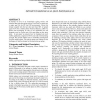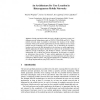115
click to vote
ACSW
2003
15 years 2 months ago
2003
Contextual information such as spatial location can significantly enhance the utility of mobile applications. We introduce the concept of active preferences that represent a comb...
BCSHCI
2008
15 years 2 months ago
2008
Our work aims to address the problems of designing health assistant applications that run on mobile devices. We discuss the lessons learnt through the design of a mobile applicati...
BCSHCI
2008
15 years 2 months ago
2008
In Europe we live in an increasingly ageing society and solutions that help that ageing society to self care in context are a major goal for the EU and UK governments. Given this ...
107
click to vote
MOBILWARE
2009
ACM
15 years 5 months ago
2009
ACM
Major software companies, such as Apple and Google, are disturbing the relatively safe and established actors of the mobile application business. These newcomers have caused signi�...
117
click to vote
AINA
2003
IEEE
15 years 6 months ago
2003
IEEE
The use of mobile applications is increasing rapidly. Particularly, mobile applications for decision support systems, such as mobile datawarehouses, are very attractive. However, ...
98
Voted
HSNMC
2004
Springer
15 years 6 months ago
2004
Springer
Fourth generation mobile networks will allow end-users to roam over different network technologies, such as UMTS, CDMA2000 and Wi-Fi. These mobile networks make it possible to dete...
102
click to vote
PDC
2004
ACM
15 years 6 months ago
2004
ACM
This paper describes experiences from using a field testing technique for collecting user experience information for evaluating mobile applications used in everyday life. Our tech...
123
click to vote
OTM
2005
Springer
15 years 6 months ago
2005
Springer
Distributed mobile applications operate on devices with diverse capabilities, in heterogeneous environments, where parameters such as processor, memory and network utilisation, are...
106
click to vote
METRICS
2005
IEEE
15 years 6 months ago
2005
IEEE
As mobile applications become more pervasive, the need for assessing their quality, particularly in terms of efficiency (i.e. performance and resource utilisation), increases. Alt...
101
Voted
HICSS
2005
IEEE
15 years 6 months ago
2005
IEEE
While dedicated technologies such as e.g., Sun’s J2ME MIDP offer a simple programming model for mobile applications, appropriate support for modularizing the implementation of t...






